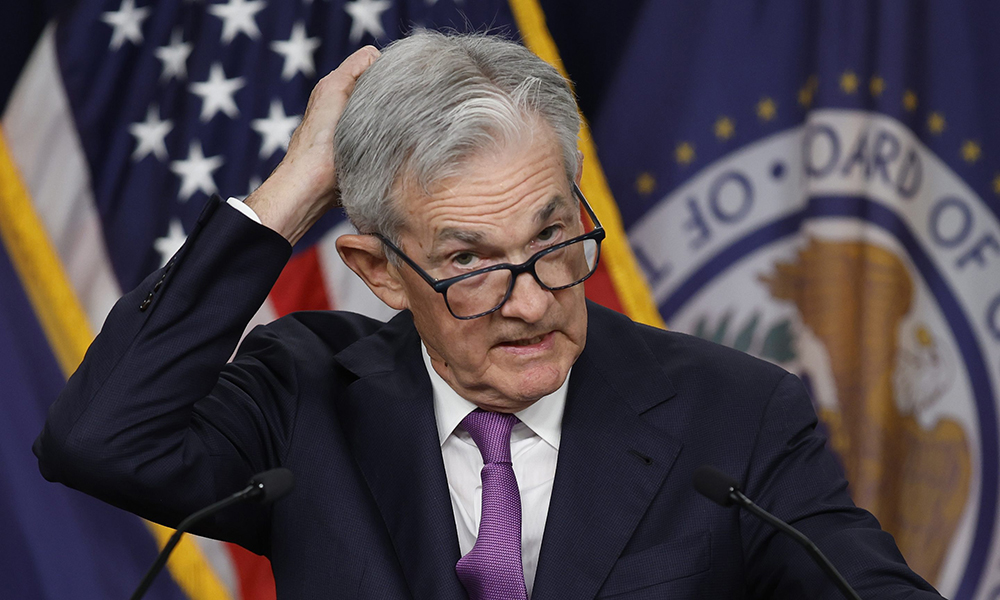
上個(gè)月,美國(guó)的批發(fā)物價(jià)達(dá)到了自4月以來(lái)的最快上漲速度。這表明盡管美國(guó)已經(jīng)進(jìn)行了一年半的加息,通脹壓力仍然存在。
美國(guó)勞工部(Labor Department)周三報(bào)告稱,美國(guó)的生產(chǎn)物價(jià)指數(shù)同比上漲2.2%。生產(chǎn)物價(jià)指數(shù)衡量進(jìn)入消費(fèi)環(huán)節(jié)之前的通脹。8月,該指數(shù)已經(jīng)上漲了2%。
從8月到9月,生產(chǎn)物價(jià)環(huán)比上漲0.5%,低于從7月到8月0.7%的漲幅。
在9月份,剔除了容易波動(dòng)的食品和能源價(jià)格后,核心通脹同比上漲了2.7%,較8月上漲0.3%。美聯(lián)儲(chǔ)以及眾多外部經(jīng)濟(jì)學(xué)家特別關(guān)注核心物價(jià),將其視為預(yù)測(cè)通脹走勢(shì)的可靠信號(hào)。
批發(fā)物價(jià)的上漲幅度一直低于消費(fèi)物價(jià)。隨著生產(chǎn)者將成本傳遞給消費(fèi)者,這增加了通脹持續(xù)下降的希望。但受到商品價(jià)格上漲的影響,周三公布的上個(gè)月數(shù)據(jù)卻高于經(jīng)濟(jì)學(xué)家的預(yù)期。上個(gè)月,批發(fā)食品價(jià)格較8月上漲了0.9%,而從7月到8月批發(fā)食品價(jià)格下跌了0.5%。
去年,通脹達(dá)到了四十年來(lái)的最高水平,這促使美聯(lián)儲(chǔ)采取激進(jìn)的加息措施。自2022年3月以來(lái),美國(guó)央行已經(jīng)11次提高了基準(zhǔn)利率。更高的借款成本確實(shí)有助于抑制通脹,并導(dǎo)致依然穩(wěn)固的就業(yè)市場(chǎng)增長(zhǎng)放緩。
有越來(lái)越多人預(yù)測(cè),美聯(lián)儲(chǔ)在今年剩余時(shí)間可能不會(huì)調(diào)整利率。周一,兩位美聯(lián)儲(chǔ)官員表示,在三周后召開(kāi)的央行會(huì)議上,美聯(lián)儲(chǔ)可能不會(huì)調(diào)整關(guān)鍵利率,這番言論幫助刺激了債市和股市上漲。
高頻經(jīng)濟(jì)(High Frequency Economics)首席美國(guó)經(jīng)濟(jì)學(xué)家比埃拉·法魯奇表示,上個(gè)月更高的生產(chǎn)物價(jià)“可能不會(huì)改變美聯(lián)儲(chǔ)的政策前景。我們的基準(zhǔn)情景依舊是美聯(lián)儲(chǔ)將維持高利率。對(duì)于美聯(lián)儲(chǔ)而言,地緣政治發(fā)展是一個(gè)額外的風(fēng)險(xiǎn)因素,這可能讓政策制定者未來(lái)繼續(xù)保持謹(jǐn)慎。”
與此同時(shí),美國(guó)經(jīng)濟(jì)的表現(xiàn)比預(yù)期的更加堅(jiān)挺。越來(lái)越多的人樂(lè)觀地認(rèn)為美聯(lián)儲(chǔ)能夠?qū)崿F(xiàn)“軟著陸”,即加息足以控制通貨膨脹,但不會(huì)導(dǎo)致經(jīng)濟(jì)陷入嚴(yán)重衰退。
美國(guó)勞工部將在周四發(fā)布備受關(guān)注的9月份消費(fèi)物價(jià)指數(shù)。上個(gè)月,該部門公布的數(shù)據(jù)顯示,與一年前相比,8月的核心消費(fèi)物價(jià)創(chuàng)下近兩年來(lái)的最小漲幅。(財(cái)富中文網(wǎng))
翻譯:劉進(jìn)龍
審校:汪皓
上個(gè)月,美國(guó)的批發(fā)物價(jià)達(dá)到了自4月以來(lái)的最快上漲速度。這表明盡管美國(guó)已經(jīng)進(jìn)行了一年半的加息,通脹壓力仍然存在。
美國(guó)勞工部(Labor Department)周三報(bào)告稱,美國(guó)的生產(chǎn)物價(jià)指數(shù)同比上漲2.2%。生產(chǎn)物價(jià)指數(shù)衡量進(jìn)入消費(fèi)環(huán)節(jié)之前的通脹。8月,該指數(shù)已經(jīng)上漲了2%。
從8月到9月,生產(chǎn)物價(jià)環(huán)比上漲0.5%,低于從7月到8月0.7%的漲幅。
在9月份,剔除了容易波動(dòng)的食品和能源價(jià)格后,核心通脹同比上漲了2.7%,較8月上漲0.3%。美聯(lián)儲(chǔ)以及眾多外部經(jīng)濟(jì)學(xué)家特別關(guān)注核心物價(jià),將其視為預(yù)測(cè)通脹走勢(shì)的可靠信號(hào)。
批發(fā)物價(jià)的上漲幅度一直低于消費(fèi)物價(jià)。隨著生產(chǎn)者將成本傳遞給消費(fèi)者,這增加了通脹持續(xù)下降的希望。但受到商品價(jià)格上漲的影響,周三公布的上個(gè)月數(shù)據(jù)卻高于經(jīng)濟(jì)學(xué)家的預(yù)期。上個(gè)月,批發(fā)食品價(jià)格較8月上漲了0.9%,而從7月到8月批發(fā)食品價(jià)格下跌了0.5%。
去年,通脹達(dá)到了四十年來(lái)的最高水平,這促使美聯(lián)儲(chǔ)采取激進(jìn)的加息措施。自2022年3月以來(lái),美國(guó)央行已經(jīng)11次提高了基準(zhǔn)利率。更高的借款成本確實(shí)有助于抑制通脹,并導(dǎo)致依然穩(wěn)固的就業(yè)市場(chǎng)增長(zhǎng)放緩。
有越來(lái)越多人預(yù)測(cè),美聯(lián)儲(chǔ)在今年剩余時(shí)間可能不會(huì)調(diào)整利率。周一,兩位美聯(lián)儲(chǔ)官員表示,在三周后召開(kāi)的央行會(huì)議上,美聯(lián)儲(chǔ)可能不會(huì)調(diào)整關(guān)鍵利率,這番言論幫助刺激了債市和股市上漲。
高頻經(jīng)濟(jì)(High Frequency Economics)首席美國(guó)經(jīng)濟(jì)學(xué)家比埃拉·法魯奇表示,上個(gè)月更高的生產(chǎn)物價(jià)“可能不會(huì)改變美聯(lián)儲(chǔ)的政策前景。我們的基準(zhǔn)情景依舊是美聯(lián)儲(chǔ)將維持高利率。對(duì)于美聯(lián)儲(chǔ)而言,地緣政治發(fā)展是一個(gè)額外的風(fēng)險(xiǎn)因素,這可能讓政策制定者未來(lái)繼續(xù)保持謹(jǐn)慎。”
與此同時(shí),美國(guó)經(jīng)濟(jì)的表現(xiàn)比預(yù)期的更加堅(jiān)挺。越來(lái)越多的人樂(lè)觀地認(rèn)為美聯(lián)儲(chǔ)能夠?qū)崿F(xiàn)“軟著陸”,即加息足以控制通貨膨脹,但不會(huì)導(dǎo)致經(jīng)濟(jì)陷入嚴(yán)重衰退。
美國(guó)勞工部將在周四發(fā)布備受關(guān)注的9月份消費(fèi)物價(jià)指數(shù)。上個(gè)月,該部門公布的數(shù)據(jù)顯示,與一年前相比,8月的核心消費(fèi)物價(jià)創(chuàng)下近兩年來(lái)的最小漲幅。(財(cái)富中文網(wǎng))
翻譯:劉進(jìn)龍
審校:汪皓
U.S. wholesale prices rose last month at the fastest pace since April, suggesting that inflationary pressures remain despite a year and a half of higher interest rates.
The Labor Department reported Wednesday that its producer price index — which measures inflation before it hits consumers — climbed 2.2% from a year earlier. That was up from a 2% uptick in August.
On a month-to-month basis, producer prices rose 0.5% from August to September, down from 0.7% from July to August.
Excluding volatile food and energy prices, so-called core inflation rose 2.7% in September from a year earlier and 0.3% from August. The Federal Reserve and many outside economists pay particular attention to core prices as a good signal of where inflation might be headed.
Wholesale prices have been rising more slowly than consumer prices, raising hopes that inflation may continue to ease as producer costs make their way to the consumer. But Wednesday’s numbers, driven by an uptick in the price of goods, came in higher last month than economists had expected. Wholesale food prices rose 0.9% last month from August after tumbling 0.5% from July to August.
Last year, inflation reached highs not seen in four decades, prompting the Fed to raise interest rates aggressively. The central bank has boosted its benchmark rate 11 times since March 2022. Those higher borrowing costs have helped cool inflation and slow a still-solid job market.
There are growing expectations that the Fed may decide to leave interest rates alone for the rest of the year. On Monday, two Fed officials suggested that the central bank may leave its key rate unchanged at its next meeting in three weeks, helping touch off a rally in bonds and stocks.
Rubeela Farooqi, chief U.S. economist at High Frequency Economics, said last month’s higher producer prices “l(fā)ikely do not change the outlook for Fed policy. Our baseline remains that rates are at a peak. For the Fed, geopolitical developments will be an additional risk factor which will likely keep policymakers proceeding cautiously going forward.″
In the meantime, the economy has remained sturdier than expected. Optimism is rising that the Fed may pull off a ”soft landing” — raising rates just enough to tame inflation without tipping the economy into a deep recession.
On Thursday, the Labor Department will issue its closely watched consumer price index for September. Last month, the department reported that compared with 12 months earlier, core consumer prices in August rose at the smallest pace in nearly two years.






